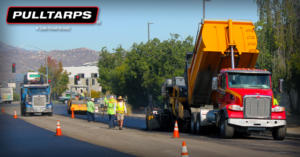Hauling Industry News
Five Safety Awareness Tips for Asphalt Paving
 Story by Jessica Lombardo / www.forconstructionpros.com
Story by Jessica Lombardo / www.forconstructionpros.com
Here are five tips that you can easily print out and give to your crew. Encourage them to read it daily. You never know when it could save a life.
1. Take Care When Getting On and Off Equipment
Did you know that getting on and off the machine is the number one cause of injury to equipment operators, forklift drivers and truck drivers? This is unfortunately apparent with one of the above accidents. When it comes to a moving piece of equipment like a paver, making sure you’re mounting and exiting the machine properly is paramount to your safety.
First, check your gloves and boots. Clean the mud off before climbing, and use “high grip” gloves for a secure hand hold. Next, use a three-point stance going and coming. Use large size hand and foot holds. Securely engage the entire hand and foot, avoiding a toe-hold or finger-hold grip. Use a step ladder for access when no hand or foot holds are provided. Avoid carrying objects while climbing.
If the machine needs additional hand holds or steps installed, do it. Operators come in different sizes. Make it as easy and safe as possible to ascend/descend. Avoid the need to stretch by putting the grab rails where they’re easy to securely reach.
When exiting the machine, correct practice is to lower yourself in a controlled manner – never jump!
2. Don’t Let People Crowd the Work Area
Ask any roller operator what their biggest headache is and they will tell you without hesitation – people on the ground crowding the machine. People love to stand and watch the operator compact the mat. There is usually no reason for them to be there, just force of habit. But why create an exposure to injury when none needs to exist?
People on the ground must stay well away from the machine operating area. Review this important point at safety meetings. Foremen need to enforce this, not the operator.
When ready to start work, use the horn to warn people to stay back; stop the machine if needed; and always check your back before backing up the machine.
3. Overhead/Buried Obstructions
Be aware of overhead obstructions and underground utilities, including electrical lines, water, sewer, gas, telecom, etc.
Definitively mark or warn of overhead lines or low clearances and make sure all dump operators are aware of these before entering the work zone.
Use sawhorses, signs, barrier tapes, etc., to indicate obstructions. Take no chances. The crew in South Carolina sure wishes they didn’t.
4. Loading/Unloading Equipment
Even on level ground, there is a risk of machine roll-over during loading or unloading. Make sure you are centered on the ramps and stay straight. Allow enough room to maneuver the trailer and machine, which is sometimes difficult on tightly compressed jobsites.
Use a spotter for guidance. Make sure the machine clears the ramps before turning. Keep people away from the sides of the machine during loading/unloading.
Check the trailer deck, clearances and stability. Use proper tie-down procedures. If using compression chain binders, use caution when opening the handle. The load may shift just enough to add tension to the chain and the handle may spring open. Use safety tie wires or switch to ratchet binders.
5. Properly Secure Paving Area
Training your crew to be safe is just the beginning. They also need to be kept safe from the traveling public. This is best accomplished by crew members that are visible in a work zone that is well marked with signs and barricades to let drivers know to stay out or slow down.
Contractors should devise temporary traffic control plans (TCPs) for their sites, as well as follow the standards as specified in part six of the Federal Highway Administration’s Manual on Uniform Traffic Control Devices (MUTCD).
Ample lighting should also be present in the work zone, in addition to mandating that all crew members wear proper reflective safety apparel. The lighting should be installed to ensure proper illumination for workers, while minimizing glare. Workers should be encouraged to stay clear of unlit areas.
We don’t want your crew to be a headline for an accident. Take time to review safety with your crew daily. You can never talk about it enough.